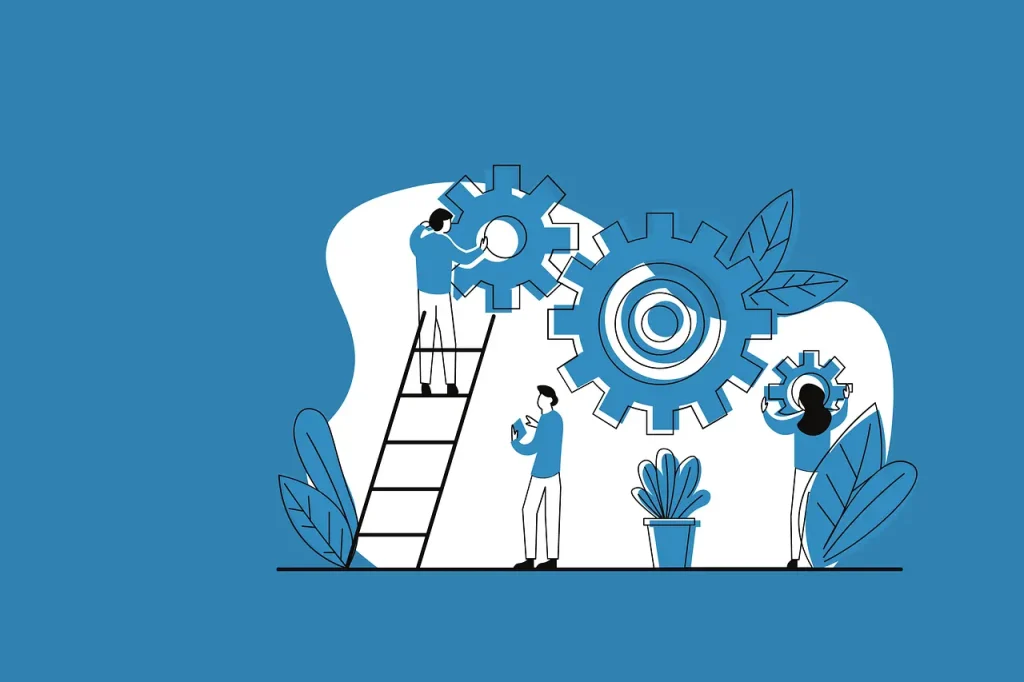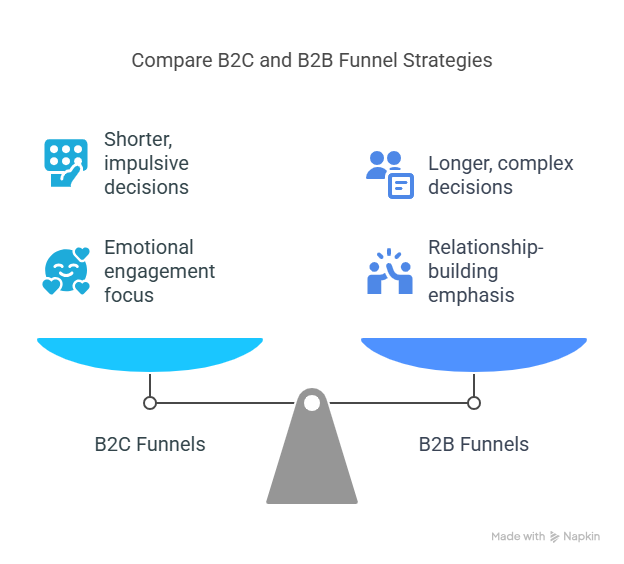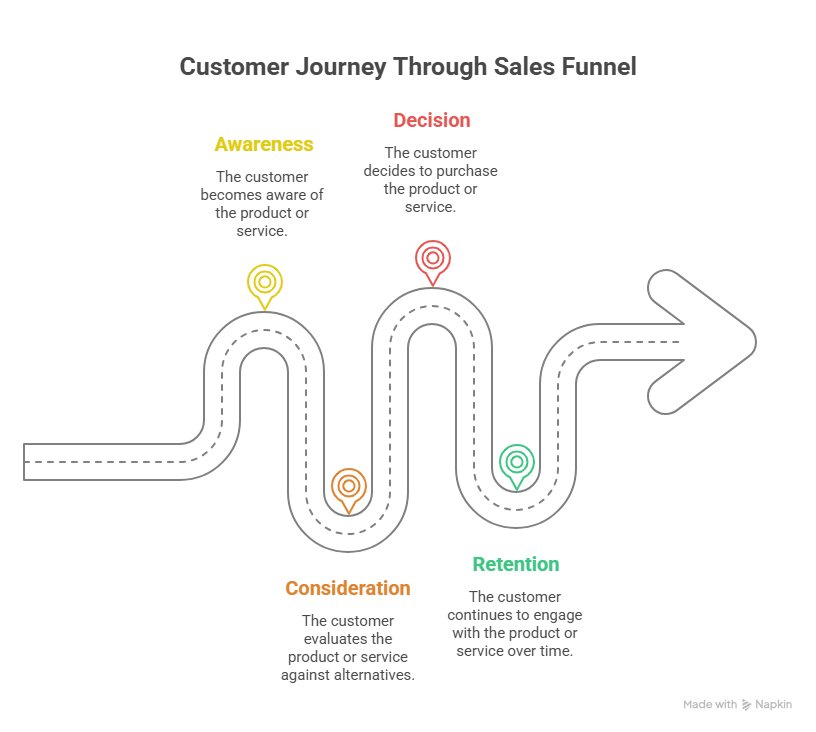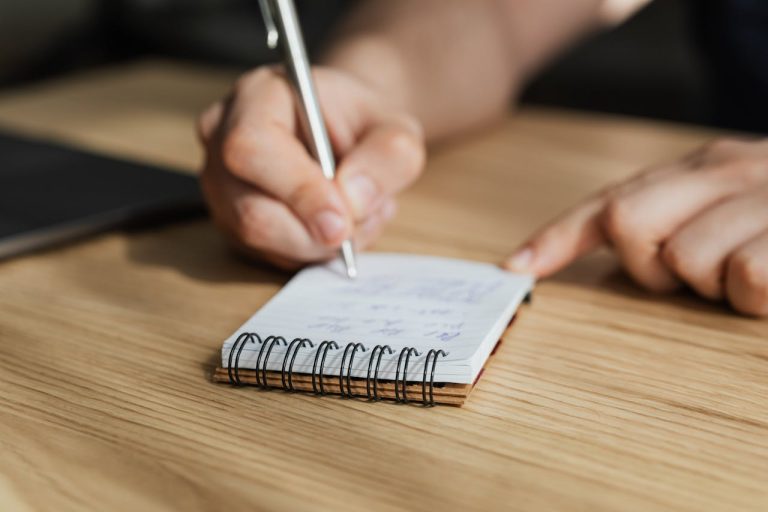

When it comes to selling directly to consumers, a strong sales funnel acts as your growth engine. The B2C sales funnel maps out every step your customer takes, from casually scrolling Instagram to smashing that “Buy” button and becoming a loyal fan.
But here’s the thing: most B2C buyers aren’t logical robots comparing features, they’re impulsive, emotionally driven, and often distracted. That’s what makes B2C funnels different from B2B ones: faster decision-making, more visual persuasion, and way less time to earn trust.
Done right, your funnel becomes a 24/7 sales machine. According to a Forrester Research study cited by Salesgenie, companies that excel at lead nurturing generate 50% more sales-ready leads at 33% lower cost.
In this guide, we’ll walk you through the key stages of a high-performing B2C funnel, common challenges, and actionable steps to build and optimize your own.
Let’s make your funnel work harder (and smarter).
Key takeaways
- A B2C sales funnel is the step-by-step path consumers take from discovering your brand to becoming a customer, and ideally, a repeat one.
- Compared to B2B, B2C funnels are faster-paced, emotion-driven, and require less information but more trust-building.
- The four core stages are: awareness, interest/consideration, decision/purchase, and loyalty/advocacy.
- Optimizing each stage leads to better conversion rates, happier customers, and higher lifetime value.
- Tools like Google Analytics, Klaviyo, and Shopify help track, test, and fine-tune your funnel for continuous improvement.
Understanding the B2C sales funnel: More than just a pathway to purchase
A B2C sales funnel is the journey a customer takes from discovering your brand to making a purchase, and ideally, becoming a loyal advocate. It’s your behind-the-scenes roadmap for turning curiosity into clicks, and clicks into customers.
But unlike B2B funnels, which tend to involve multiple decision-makers and long buying cycles, B2C funnels are faster, more emotional, and often less rational.
You’re selling to individuals, not committees, and they’re usually on their phone, half-distracted, and expecting a frictionless experience.
How B2C funnels differ from B2B
While the stages of the funnel are nearly the same, the mechanics behind the users differ:
- Shorter decision cycles: Consumers often make purchases on the spot, especially for lower-cost items.
- Emotion plays a bigger role: Visuals, brand tone, and customer reviews weigh more than product specs.
- Less information required: No need for white papers, just clear value and social proof.
- Impulse buying is common: Mobile UX, urgency, and seamless checkout matter more.

Why it matters for your bottom line
A well-structured funnel helps you:
- Target the right people with the right messaging at the right time
- Guide shoppers naturally from curiosity to conversion
- Maximize marketing ROI by focusing efforts on high-impact stages
- Turn one-time buyers into fans who come back again and again
When you understand the B2C funnel, you’re not just throwing ads into the void, you’re building a system that works even when you’re not online.
Stages of a B2C sales funnel
Knowing the ins and outs of each stage and common tactics to use to entice your audience is the first step to creating a well-oiled machine.

Stage 1: Awareness – Getting seen by the right consumers
This is your moment to make a first impression. People can’t buy from you if they don’t know you exist, so your job is to get in front of the right eyeballs – ideally, with content or messaging that sticks.
| What to Do | Why It Matters |
| Run targeted ads on social media and search | Expands your reach with your ideal audience |
| Collaborate with influencers or creators | Adds social proof and taps into existing audiences |
| Create SEO-optimized content like blogs and landing pages | Brings in organic traffic and builds authority over time |
| Get featured in relevant PR channels or roundups | Increases visibility and brand credibility |
Metrics to track to see your impact and areas to improve:
- Website traffic
- Impressions
- Social reach and engagement
- Brand search volume
Stage 2: Interest & consideration – Sparking desire and building trust
Once they know who you are, your job is to turn curiosity into genuine interest. This is where potential buyers begin researching, comparing, and deciding whether your brand fits their needs. Your content should educate, reassure, and gently guide them toward a purchase.
| What to Do | Why It Matters |
| Create product-focused blog posts, how-to videos, or comparison guides | Helps customers see how your product solves their problem |
| Share customer testimonials, ratings, or user-generated content | Builds trust and overcomes skepticism |
| Use retargeting ads to stay top-of-mind | Reminds warm leads to come back and explore more |
| Offer email sign-ups with helpful resources (discounts, style guides, etc.) | Captures leads and opens the door for nurturing |
| Post behind-the-scenes content or founder stories on social media | Adds authenticity and creates emotional connection |
Metrics to track to see what’s resonating:
- Product page views
- Time on site
- Email sign-up rate
- Social media engagement on product posts
- Click-through rate (from emails, ads, or content)
Stage 3: Decision & purchase – Making it easy to buy
Now they’re on the edge – your job is to make the final step smooth, fast, and confidence-inducing. Even small friction here can cost you the sale. But be careful! The average cart abandonment rate is around 70.19%, so sticking the landing is vital.
| What to Do | Why It Matters |
| Offer limited-time discounts or bundle deals | Creates urgency and incentivizes checkout |
| Optimize checkout for speed and clarity | Reduces bounce from confusing or slow processes |
| Provide multiple payment and shipping options | Increases convenience and trust |
| Show trust signals like secure checkout badges and return policies | Alleviates last-minute hesitation |
Metrics to track to see results:
- Conversion rate (check out our optimization guide!)
- Cart abandonment rate
- Average order value (AOV)
Cart abandonments got you down? With Deadline Funnel, you can send emails that recapture attention and make those missed sales. Learn more about our cart abandonment email solution, and try Deadline Funnel free for 14 days.
[Try 14 days free]
Stage 4: Post-purchase & loyalty – Creating brand advocates
The funnel doesn’t stop at the sale. This is your chance to turn one-time buyers into repeat customers and loyal fans, which is a massive boon and not-to-be-overlooked part of your sales funnel.
In fact, according to a long-standing study by Bain & Company, increasing customer retention by just 5% can boost profits by 25-95%.
| What to Do | Why It Matters |
| Send post-purchase emails (like thank you emails, usage tips, product care) | Keeps your brand top of mind and improves satisfaction |
| Offer loyalty or referral programs | Incentivizes repeat purchases and word-of-mouth growth |
| Ask for reviews and user-generated content | Builds trust for future buyers and strengthens social proof |
| Surprise customers with small perks | Increases emotional connection and encourages advocacy |
Metrics to Track to see where things are going right (or wrong):
- Repeat purchase rate
- Customer Lifetime Value (CLV)
- Net Promoter Score (NPS)
- Number of reviews or referrals
Building & optimizing your B2C sales funnel
Now that you know the stages, it’s time for some tips and best practices for long-term success.
1. Know your ideal B2C customer deeply
Before you write a single ad or launch a campaign, get clear on who you’re talking to.
Build detailed personas that include:
- Age, income, location
- Values and interests
- Online habits
- Pain points and buying motivations
Use real data to guide this: send out customer surveys, comb through reviews, and track behavior via social media interactions or tools like Google Analytics. The better you understand your audience, the more tailored – and effective – your funnel will be.
How To Create a Buyer Persona (FREE Template)
2. Map their customer journey
Not every buyer takes a straight path from awareness to purchase. Outline how your typical customer discovers, evaluates, and eventually buys a product like yours.
Ask questions like:
- Where do they first hear about you?
- What kind of research do they do before buying?
- What turns interest into action?
This helps you design a funnel that mirrors real behavior, not assumptions. Use journey mapping tools or even a whiteboard to sketch this out by hand.
3. Match your channels and content to each stage
Now, plug in content and campaigns that match each phase of the funnel. Here’s a quick overview:
| Funnel Stage | Content & Channel Ideas |
| Awareness | Influencer campaigns, viral videos, SEO blog posts, TikTok/Reels |
| Consideration | Comparison guides, email welcome series, user-generated content |
| Decision | Cart abandonment emails, limited-time offers, exit-intent popups |
| Loyalty | Referral programs, reorder reminders, VIP offers |
💡 Pro tip: Make sure each content piece answers the question your customer is asking at that stage. Don’t push discounts too early or throw in product specs before they’re even interested!
4. Track What Matters
You can’t fix what you don’t measure. Set up systems to monitor performance across all stages.
Break it down:
- Use Google Analytics for traffic patterns, bounce rates, and conversion goals
- Check your email platform (like Mailchimp or Klaviyo) for open and click-through rates
- Look at social media insights for engagement and referral traffic
- Run customer satisfaction surveys or collect post-purchase reviews to understand experience and sentiment
💡 Pro tip: Consider creating a dashboard to see key funnel metrics at a glance.
5. Test, Iterate, Improve
Funnels are never “set and forget.” Keep refining by A/B testing:
- Headlines and CTAs
- Landing page design
- Subject lines in emails
- Time delays in your drip campaigns
Watch closely for high bounce rates, low click-throughs, or cart abandonment spikes. Even small adjustments, like rewording a CTA or moving a product image, can lead to major improvements.
Use tools like Google Optimize, Hotjar, or Deadline Funnel to test and tweak efficiently.
By focusing on data, strategy, and continuous improvement, your B2C funnel can become a finely tuned system that consistently attracts, converts, and retains customers.
Common B2C funnel challenges & how to overcome them
Even well-structured funnels can hit snags. Here are some of the most common B2C sales funnel issues and how to fix them:
Problem: Low website traffic (top of funnel)
What’s going wrong:
If you’re not attracting visitors, chances are your brand isn’t showing up where your audience hangs out, or your content isn’t enticing enough to click on.
Fix it with:
- SEO-optimized product and blog pages that target long-tail keywords
- Paid campaigns on social or Google that reach your ideal customer
- Engaging content that educates or entertains, not just sells
Problem: High bounce rate on product pages (consideration stage)
What’s going wrong:
People are landing on your product pages and leaving fast. This often points to slow load times, weak design, or missing information that would help them feel confident buying.
Fix it with:
- Speeding up your site (especially for mobile users)
- Adding product reviews, FAQ sections, and high-quality imagery
- Using heatmaps or session recordings to uncover where people lose interest
Problem: High cart abandonment (decision stage)
What’s going wrong:
Shoppers are bailing right before buying. That’s usually due to surprise costs, clunky checkout processes, or plain old hesitation.
Fix it with:
- Being upfront about shipping and pricing from the start
- Offering guest checkout and mobile-friendly payment options
- Sending cart recovery emails or using exit-intent popups with gentle nudges
Problem: Low repeat purchase rate (post-purchase stage)
What’s going wrong:
You made the sale, but gave customers no reason to return. A lack of follow-up means you’re missing out on long-term value.
Fix it with:
- Sending post-purchase email flows with tips, upsells, or reorder links
- Creating loyalty or referral programs that reward repeat buyers
- Asking for feedback and showing customers how it’s used
Some problems are simple fixes, while others may need tools to fix. Next, here are some tools to give you a helping hand on your journey.
Essential tools to power your B2C sales funnel
A well-oiled funnel runs on the right mix of tools — not just to sell, but to track, nurture, and scale. Here’s a quick look at the must-haves across the funnel journey:
| Tool Category | Examples | What It Helps With |
| E-commerce platforms | Shopify, WooCommerce | Hosting your store, managing products, processing orders |
| Email marketing tools | Klaviyo, Mailchimp | Automating flows, segmenting audiences, sending targeted emails |
| Social media schedulers | Buffer, Hootsuite | Managing posts, tracking engagement, streamlining content plans |
| Funnel automation & urgency | Deadline Funnel | Adding countdowns, scarcity, and urgency to drive conversions |
| Analytics platforms | Google Analytics, Hotjar | Tracking user behavior, identifying drop-offs, optimizing UX |
| CRM (lightweight for B2C) | HubSpot CRM, Brevo, Drip | Managing customer data, segmenting leads |
| Landing page builders (optional) | Unbounce, Leadpages | Creating high-converting pages for campaigns |
These tools don’t have to break your workflow – many integrate with each other, so you can plug them into your existing tech stack without disruption.
Conclusion: Making your B2C funnel work for you
A strong B2C sales funnel isn’t just a nice-to-have – it’s your foundation for sustainable growth. Whether you’re selling skincare, subscriptions, or sneakers, your funnel is what turns casual browsers into loyal buyers.
If you want your funnel to actually work, it needs more than traffic and good intentions. It needs structure, data, and a willingness to test and tweak. From top-of-funnel awareness to long-term retention, every stage is a chance to connect with your audience and nudge them closer to purchase.
So here’s your move:
- Review your current funnel (or build one from scratch using the steps above)
- Choose tools that help you automate, personalize, and optimize
- Track the right metrics, fix the leaks, and keep evolving
The brands that win aren’t just the ones with great products, they’re the ones with great systems. Start building yours today.
Want to drive more conversions with real urgency – without being pushy?
Try Deadline Funnel free for 14 days and see how evergreen countdowns and personalized deadlines can power up your B2C funnel.




